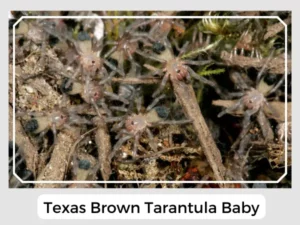The Texas brown tarantula has a few other names, like the Oklahoma brown tarantula and the Missouri tarantula. It’s a spider you can often see in the southern areas of the USA. In this post, we’re going to share some interesting facts about this big, fuzzy spider.
Female spiders make egg sacs 4-5 months after copulation, and around 1,000 eggs are discharged there. The eggs remain securely encased within a web resembling a hammock, made inside their burrows. It takes 45-60 days for the eggs to hatch.
Post-hatching, the spiderlings often stay with their mothers for a few days and then go on to make their own burrows.

Photo Credit: Chris
This tarantula species predominantly resides in burrows, which they secure using web-like structures resembling a hammock at the entrance. These burrows are typically located in grasslands and may sometimes be found in abandoned underground dens of other animals.
Yes, the Texas Brown Tarantula has venom. But it’s mainly used to catch their food. For people, it’s usually not very harmful.
Texas Brown Tarantulas can bite if they feel threatened. But they mostly prefer to stay away and be peaceful.
The Texas brown tarantula plays an important role in maintaining the ecological balance within its habitat. As a predator, it helps control the populations of various insects, including grasshoppers, cockroaches, and crickets. Its presence contributes to the stability of the food web, showcasing the interconnectedness of species within the ecosystem.
Natural Predator: Despite their size and predatory nature, Texas brown tarantulas are not without threats. They fall prey to tarantula hawks, a species of parasitic wasp. The female wasp stings and paralyzes the tarantula before laying an egg on its body. Once the egg hatches, the larva feeds on the still-living tarantula, highlighting the harsh realities of nature.
Prey-Predator Dynamics: The relationship between the Texas brown tarantula and its prey is a classic example of the predator-prey dynamics that drive ecological systems. The tarantula’s hunting prowess ensures the control of insect populations, while the threats from its natural predators keep its own numbers in check.
Relationship with Humans: While some people may fear or be uneasy around tarantulas, the Texas brown tarantula is generally harmless to humans. It plays a beneficial role in pest control, helping to reduce the populations of insects that may be considered nuisances.
| Other Names | Missouri tarantula, Oklahoma brown tarantula |
| Distribution | Louisiana, Arkansas, New Mexico, Kansas, Texas, Oklahoma, Missouri, and Colorado |
| Habitat | Burrows, grasslands, abandoned underground dens of other animals |
| Diet | Grasshoppers, cockroaches, and crickets |
| Lifespan | Females: 36-40 years Males: 12-15 years |
| IUCN Conservation Status | Not Listed |
In summary, the Texas brown tarantula is a fascinating species with a unique set of characteristics and an important role in its ecosystem. Its impressive size, distinctive appearance, and intriguing behaviors make it a subject of interest for both researchers and enthusiasts.
The Texas brown tarantula has a few other names, like the Oklahoma brown tarantula and the Missouri tarantula. It’s a spider you can often see in the southern areas of the USA. In this post, we’re going to share some interesting facts about this big, fuzzy spider.
Female spiders make egg sacs 4-5 months after copulation, and around 1,000 eggs are discharged there. The eggs remain securely encased within a web resembling a hammock, made inside their burrows. It takes 45-60 days for the eggs to hatch.
Post-hatching, the spiderlings often stay with their mothers for a few days and then go on to make their own burrows.

Photo Credit: Chris
This tarantula species predominantly resides in burrows, which they secure using web-like structures resembling a hammock at the entrance. These burrows are typically located in grasslands and may sometimes be found in abandoned underground dens of other animals.
Yes, the Texas Brown Tarantula has venom. But it’s mainly used to catch their food. For people, it’s usually not very harmful.
Texas Brown Tarantulas can bite if they feel threatened. But they mostly prefer to stay away and be peaceful.
The Texas brown tarantula plays an important role in maintaining the ecological balance within its habitat. As a predator, it helps control the populations of various insects, including grasshoppers, cockroaches, and crickets. Its presence contributes to the stability of the food web, showcasing the interconnectedness of species within the ecosystem.
Natural Predator: Despite their size and predatory nature, Texas brown tarantulas are not without threats. They fall prey to tarantula hawks, a species of parasitic wasp. The female wasp stings and paralyzes the tarantula before laying an egg on its body. Once the egg hatches, the larva feeds on the still-living tarantula, highlighting the harsh realities of nature.
Prey-Predator Dynamics: The relationship between the Texas brown tarantula and its prey is a classic example of the predator-prey dynamics that drive ecological systems. The tarantula’s hunting prowess ensures the control of insect populations, while the threats from its natural predators keep its own numbers in check.
Relationship with Humans: While some people may fear or be uneasy around tarantulas, the Texas brown tarantula is generally harmless to humans. It plays a beneficial role in pest control, helping to reduce the populations of insects that may be considered nuisances.
| Other Names | Missouri tarantula, Oklahoma brown tarantula |
| Distribution | Louisiana, Arkansas, New Mexico, Kansas, Texas, Oklahoma, Missouri, and Colorado |
| Habitat | Burrows, grasslands, abandoned underground dens of other animals |
| Diet | Grasshoppers, cockroaches, and crickets |
| Lifespan | Females: 36-40 years Males: 12-15 years |
| IUCN Conservation Status | Not Listed |
In summary, the Texas brown tarantula is a fascinating species with a unique set of characteristics and an important role in its ecosystem. Its impressive size, distinctive appearance, and intriguing behaviors make it a subject of interest for both researchers and enthusiasts.